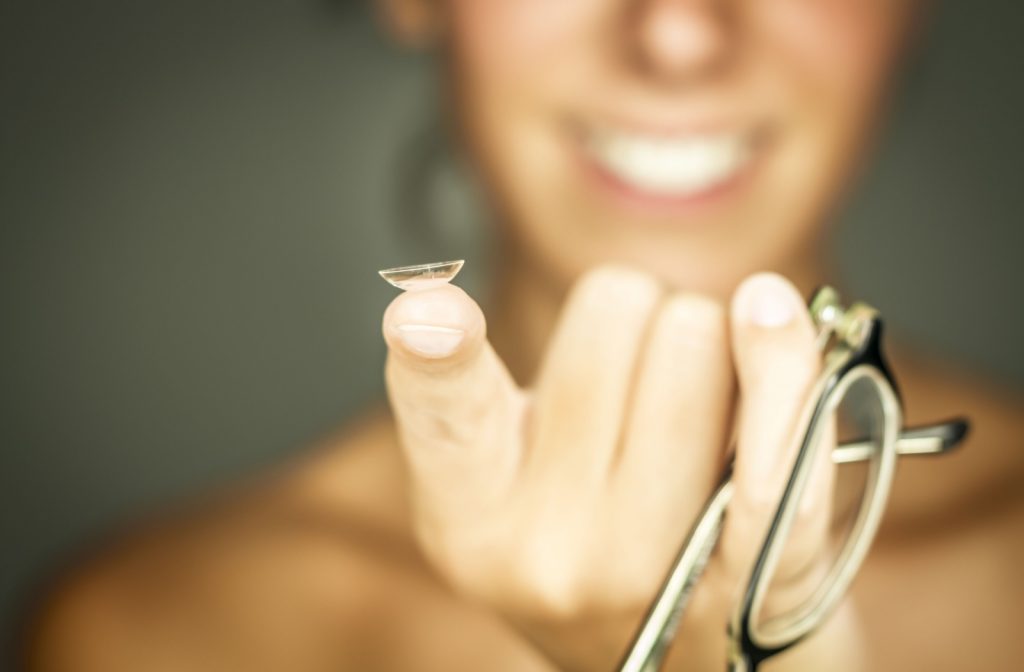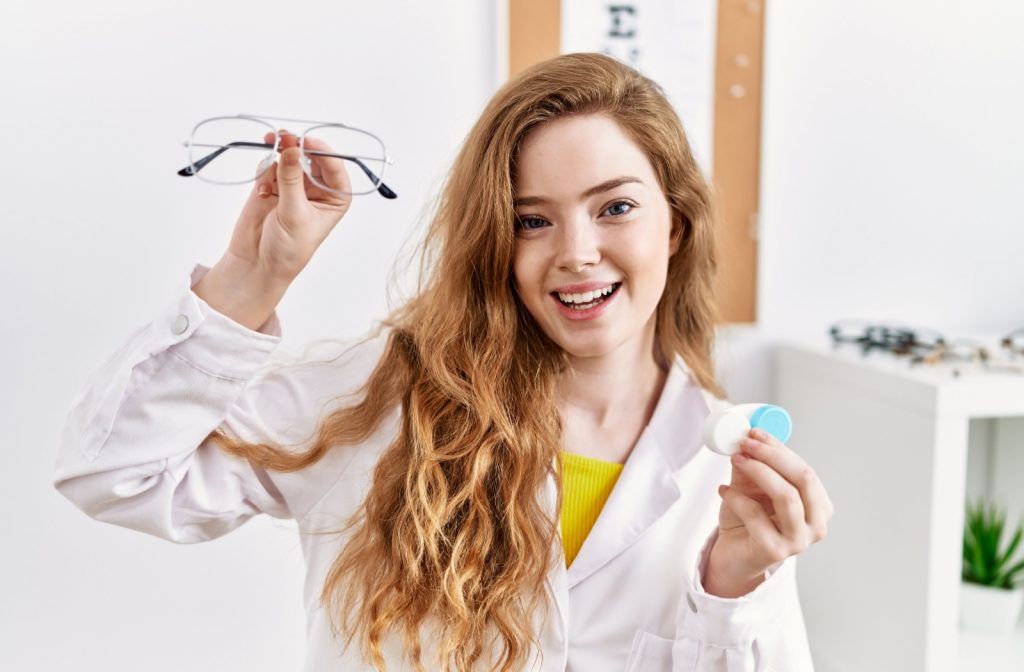Many people assume that once they have a glasses prescription, they can simply order contact lenses using the same numbers.
It’s a common misconception that can lead to discomfort, poor vision, and even eye health complications because contact lens prescriptions are not the same as glasses.
Each prescription is tailored to how and where the corrective lens sits in relation to your eye. Even brand to brand, different contact lenses fit differently. That’s why the extra measurements taken during a contact lens exam and fitting are so important.
Are Contact & Glasses Prescriptions the Same?
No, contact lens prescriptions and glasses prescriptions are not the same. While both correct refractive errors like nearsightedness, farsightedness, and astigmatism, they require different measurements and specifications due to their distinct positioning relative to your eyes.
Glasses sit away from your eyes, while contact lenses rest directly on the tear film that covers your cornea. The difference in distance significantly affects how light enters your eye and how your eye doctor calculates your prescription.
The power requirements often differ between the 2 types of prescriptions. Additionally, contact lenses must account for the curvature of your eye, something that glasses prescriptions don’t need to consider.
What’s in a Glasses Prescription?
If you already wear eyeglasses, you may be familiar with how a glasses prescription focuses on different measurements:
- Sphere (SPH)
- Cylinder (CYL)
- Axis
- Add power
- Pupillary distance (PD)
- Prism
Unlike contact prescriptions, glasses prescriptions don’t include base curve or diameter measurements since the lenses don’t need to conform to your eye’s shape.
What’s in a Contact Lens Prescription?
A contact lens prescription contains several specific measurements that don’t appear on glasses prescriptions:
- Base curve (BC)
- Diameter (DIA)
Why Does Fit Matter?
Your prescription will also specify the exact brand and type of contact lens that works for your eyes, as different materials have varying oxygen permeability and moisture content.
The fit of your contact lenses directly impacts your comfort, vision quality, and eye health. A lens that’s too steep can restrict oxygen flow and cause discomfort; in contrast, a lens that’s too flat may move excessively and provide inconsistent vision.
Why Do You Need a Separate Exam for Contacts?
Contact lens fittings allow for additional measurements and assessments beyond a standard eye exam. Your eye doctor needs to evaluate your tear film quality, corneal curvature, and overall eye health to determine if you’re a good candidate for contacts.
The fitting process also typically involves trying different lens types to find a comfortable match for your eyes. The process may include testing various materials, brands, or designs to improve comfort and vision quality.

What Happens During a Contact Lens Exam?
Your contact lens examination will often include several specific steps or tests:
- Corneal mapping uses instruments like keratometers or corneal topographers to measure the curvature & shape of your cornea
- Tear film assessment evaluates the quality & quantity of your tears to assess if your eye health can support contact lens wear
- Lid & lash evaluation helps determine if you have conditions that might interfere with contact lens wear, such as blepharitis
- Movement assessment is when your eye doctor can watch how the lenses move on your eyes with blinking & eye movements
- Trial lens fitting lets you try on a pair to assess fit, comfort, & vision quality, allowing your optometrist to make personalized adjustments when needed
Based on all these factors, your eye doctor can provide your final prescription.
What Happens If You Use a Glasses Prescription for Contacts?
Simply put, you can’t use a glasses prescription to order contact lenses, as lenses are regulated medical devices that require a legitimate, current prescription. But, if you were to use the same prescription, the inappropriate measurements could result in several problems:
- Blurred vision, as the incorrect power calculation can cause poor visual acuity, making it difficult to see clearly at various distances
- Eye strain & headaches, as your eyes may work harder to compensate for the incorrect prescription, leading to fatigue & discomfort
- Improper fit, as without the base curve & diameter measurements, lenses may not fit correctly, causing irritation or falling out
- Corneal damage, as poorly fitted lenses can scratch your cornea or restrict oxygen flow, potentially leading to serious complications
- Increased risk of infection, as improperly fitted lenses can trap bacteria & debris, increasing your risk of eye infections
Can Everyone Wear Contact Lenses?
While most people can successfully wear contact lenses, certain factors can make you an ideal candidate:
- Stable prescriptions
- People with consistent vision correction needs typically do well with contact lenses
- Good eye health
- Chronic eye conditions, like dry eye, allergies, or frequent infections, can disrupt comfort & decrease vision quality
- Proper hygiene habits
- People who can maintain good hand hygiene & follow care instructions are more likely to succeed with contact lenses
- Realistic expectations
- Understanding that contacts require more maintenance than glasses helps promote your long-term success
- Active lifestyles
- People who participate in sports or prefer the wider field of vision that contacts provide often find them beneficial
There are several reasons you may have difficulty wearing contact lenses:
- Dry eye
- Insufficient tear production can cause discomfort & potentially cause damage to the eye’s surface when wearing contacts
- Frequent eye infections
- People prone to eye infections may need to avoid contact lenses or use them only occasionally to prevent complications
- Handling difficulties
- People with arthritis or other conditions that affect dexterity might find lens insertion & removal challenging
- Allergies
- Severe environmental allergies can make contact lens wear uncomfortable during certain seasons
- Certain medications
- Some medications can affect tear production or eye health, making contact lens wear less suitable
Schedule Your Contact Lens Exam Today
If you’re considering contact lenses or need to update your current prescription, don’t rely on your glasses prescription. A comprehensive contact lens examination enables you to receive the proper fit, prescription, and care instructions for safe and comfortable lens wear.
Our experienced team provides thorough contact lens fittings using modern technology and techniques. We’ll work with you to find lenses that suit your lifestyle and vision needs, providing enhanced comfort and visual performance.Contact us today at Calgary Optometry Centre to book your appointment and take the first step toward the freedom and convenience that properly fitted contact lenses can provide.




